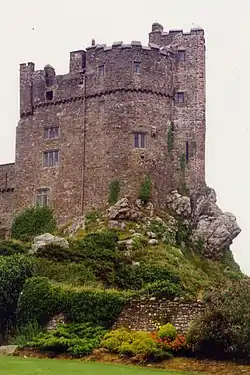Roch Castle
Roch Castle (Welsh: Castell y Garn) is a 12th-century castle, located at Roch near Haverfordwest, Wales.
| Roch Castle | |
|---|---|
| Roch, Haverfordwest, Wales | |
 | |
| Height | Up to 30 metres (98 ft) |
| Site information | |
| Owner | Griffiths-Roch Foundation |
| Site history | |
| Built | Second half, 12th century |
| Built by | Adam de Rupe |
| In use | Private |
| Events | English Civil War |
Listed Building – Grade I | |
Built by Norman knight Adam de Rupe in the second half of the 12th century,[1] probably on the site of an earlier wooden structure. Roche is the usual French word for rock, while rupestre signifies a plant growing among rocks.[2]
Built at the same time as Pill Priory near Milford Haven, Roch Castle was probably built in this location as one of the outer defences of "Little England" or "Landsker", as it is located near the unmarked border which for centuries has separated the English and Welsh areas of Pembrokeshire.[3]
After the deRupe family died out in the 15th century, the Castle was taken over eventually in the 17th century by the Walter family. Their daughter Lucy was born in the castle, and later became a courtesan of Charles II, and bore him an acknowledged son James, 1st Duke of Monmouth.
During the English Civil War, the Walter family declared for King Charles I. Although Pembrokeshire was initially Royalist, the Puritans gained the upper hand. The castle changed hands twice, before the Walter family fled when it was captured for a second time by the Parliamentary forces and subsequently burned in 1644. It lay dormant and unclaimed until the return of Duke of Monmouth, who led a rebellion and was captured at the Battle of Sedgemoor, and then beheaded on 15 July 1685.
The castle remained decaying until 1900, when purchased by John Philipps, 1st Viscount St Davids, who restored it with a steel frame and new concrete floors to the designs of D. E. Thomas of Haverfordwest. Further works were carried out in 1910 and circa 1918–20, the latter by D. F. Ingleton.[1]
The Castle was purchased in 2008 by Keith Griffiths for the Griffiths-Roch Foundation and was restored for operation by the Retreats Group as a six-bedroom luxury hotel Roch Castle Hotel.[4] Completed in 2013, the restoration was designed by architects Keith Griffiths and Acanthus Holden.[5] In 2016, the hotel received a 5-Star Gold Award from the AA [6] and was named Best 5-star Hotel in Wales by Trivago.[7] It is also listed in The Independent's ‘The Big Six: British castle stay’;[8] The Guardian's ‘10 of the best cool new hotels in Wales’,[9] The Sunday Times’ ‘Ultimate 100 British Hotels’ list, The Times's Cool Hotel Guide, and was featured by BBC News,[10] WalesOnline,[11] Conde Nast Traveller [12] and more.
References
- "Roch Castle". Coflein. Retrieved 27 October 2009.
- "Roch Castle". Pembrokeshire Virtual Museum. Retrieved 27 October 2009.
- "Roch Castle". Castles Wales. Retrieved 27 October 2009.
- "Plastic wrap for castle makeover". BBC Wales. 27 October 2009. Retrieved 27 October 2009.
- "Roch Castle, Wales : Historic Pembrokeshire Building". e-architect.co.uk. Retrieved 31 January 2017.
- "AA". AA. Retrieved 3 November 2016.
- "best hotel in Wales". 22 November 2016.
- Tebbutt, Grace (20 July 2012). "The Big Six: British castle stays". The Independent. Retrieved 22 May 2019.
- "10 best cool new hotels wales". 3 June 2015.
- "Roch Castle near Haverfordwest: £6m refurbishment finished". 3 March 2012.
- "10 of the coolest NEW places to spend a night in Wales". 3 June 2015.
- "Guide to Pembrokeshire". 3 August 2016.
External links
| Wikimedia Commons has media related to Roch Castle. |